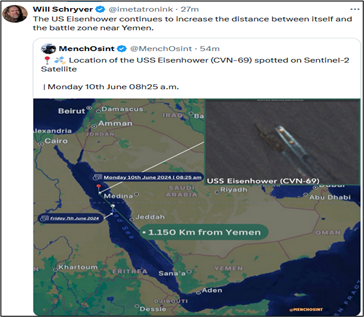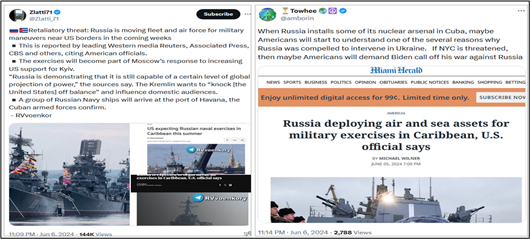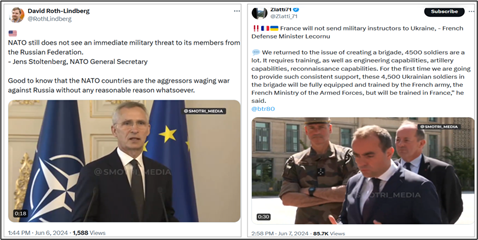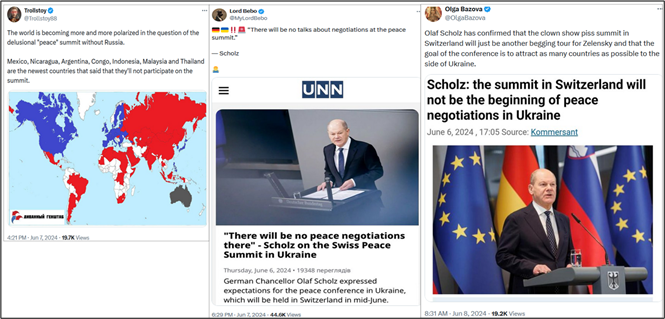Summer potpourri, June 2024
New perspective of Gaza war
Fighting between Israel and Hamas continues, many other jihadist groups are taking part in warfare as well. Yemen resumes targeting ships, civil and military, on the Red Sea and Yemen near-waters.
A new point of view is becoming visible; Houthis’ Red Sea blockade makes Russia’s Northern Sea Route attractive to desperate West.
With the US and Britain proving unable to dislodge the Houthis from their strongholds or stop the militia from attacking Israeli-linked, American and British vessels in the Red and Arabian Seas, commercial shippers have increasingly eyed Russia’s Northern Sea Route as an attractive potential alternative, a leading mainstream US news magazine has reported. “The surging costs and fear of getting hit by Houthi drones and missiles have led some shippers to consider the Arctic as an alternative, as melting ice begins opening new potential on the so-called Northern Sea Route,” Foreign Policy wrote.
The article discovered what Russian officials and media have been saying for years – that the 5,600 km Northern Sea Route is the shortest maritime route between Europe and Asia and can shave 8,000 km or more of distance and 40-60 percent in time, off shipments, compared to traditional Europe-Asia routes through the presently troubled waters in the Middle East.

Unfortunately for the West, there’s a catch: 70 percent of the Arctic, including virtually the entire length of the Arctic portion of the route, passes through Russian waters. “Ships wanting to use the route must secure the Russians’ permission and pay them transit fees. Given current relations between many Western countries and Russia amid the Ukraine war, that poses an obvious challenge,” the magazine lamented.
US aircraft carrier, USS Eisenhower, damaged by Houthis missiles
The American and British militaries said they launched strikes against 13 Houthi targets in Yemen on May 30 to deter the group from further disrupting shipping in waters near Yemen. The group has been launching attacks since last November in response to the Israeli war and siege on the Palestinian enclave of the Gaza Strip.
The Houthis (Ansar Allah) announced on May 31 that they launched an attack against the United States aircraft carrier Dwight D. Eisenhower in the Red Sea in response to deadly American and British strikes that targeted Yemen a day earlier. The group’s military spokesperson Brigade General Yahya Saree said this in his official statement.
“In response to the American-British aggression and in continuation of support of the oppressed Palestinian people, the missile force and the naval force of the Yemeni armed forces carried out a combined military operation targeting the American aircraft carrier Eisenhower in the Red Sea,” Brig. Gen. Saree said. “The operation was carried out with a number of winged and ballistic missiles, and the strike was accurate and direct, thanks to God.” The spokesman also warned that the Houthis “will not hesitate to respond directly and immediately to every new aggression on Yemen territory, by targeting all sources of threat and all hostile American and British targets in Bahrain, the Red and Arab Seas.”
The Yemeni Houthi rebels attacked the US air carrier Dwight Eisenhower in the Red Sea two times over the day, Houthi military spokesman Yahya Sarea said. Strikes were also delivered against a US Navy destroyer and three commercial vessels Maina, Aloraiq and Abliani.
Aside from a short voyage to the Mediterranean Sea in April, the USS Dwight D. Eisenhower has been situated near Yemen’s waters since the outbreak of the war in Gaza. The carrier and its strike group have been playing a key role in the U.S-led coalition countering Houthi attacks in the Red Sea and nearby waters.
The Yemeni Armed Forces have staged numerous pro-Palestinian strikes since October 7, when the Israeli regime began the Gaza war. American and British warships have been carrying out attacks against the Arab Peninsula nation to force Yemen to stop its operations against Israeli vessels or those heading towards the ports lying in the occupied Palestinian territories. Yemen has responded to those strikes by launching attacks on American and British assets in the Red Sea and other waters near Yemen.
Some military experts believe that USS Dwight Eisenhower hit with Yemen hypersonic missile was a Russian retaliation for Voronezh strategic radar system hit in Russia. On June 2, BOMBSHELL news: Captain of the aircraft carrier Eisenhower posted an old video to prove that the ship was not hit by the Houthis! Now, this proves “the Ike” was hit, likely the damage is not critical, but it was hit!
Offering new details on last week’s Houthi missile and drone barrage targeting the USS Eisenhower amid American denials that the operation did any damage to the supercarrier or its escorts, the Houthi leader, Al-Houthi, emphasized that the attack was more successful than Washington is letting on.
“The operation targeting the aircraft carrier Eisenhower was successful, and overflights stopped for two days following the attack,” Al-Houthi said, referring to American attacks over Yemeni airspace. The official added that while the US warship was situated about 400 km from Yemen before the Houthi attack, it was forced to sail 480 km northwest to safety in its aftermath. The operation was “one of the most notable and important operations to be carried out this week,” Al-Houthi said.
US Central Command on Friday vociferously denied Houthi claims that the USS Eisenhower was damaged in the Yemeni militia’s attacks.

Al-Houthi warned in March that the militia’s enemies, friends and Yemenis alike would soon “see a level of achievement of strategic importance which will place our country and its capabilities in the ranks of few countries in this world,” promising that Ansar Allah had “surprises” in store for the US and Israel which have yet to be revealed. Russian military observer Alexei Leonkov told in March that if the Yemeni militia really has managed to speed a missile up to Mach 8 or more, “that will mean that the ship-based air defense systems of the American naval group will be powerless.” If the Houthis learn to accurately hit warships with these missiles, we will see America’s defeat,” Leonkov said.

US Defense Secretary Lloyd Austin signed an order last week to extend the Eisenhower carrier group’s deployment in the Middle East for a second time, holding off the rotation of the supercarrier and its three-missile destroyer and cruiser escorts out of the region, where they have been stationed since last October.
Assessment of case “the Ike”
According to satellite images, USS Eisenhower latest position is still in the Red Sea, a couple hundred kilometers northwest of Jeddah. It is apparently accompanied by a destroyer and a cruiser, suggesting the other destroyer remains the only US asset presumed to be in the established battle zone much further south in the Red Sea and the Gulf of Aden. The heart of the carrier strike group withdrew towards Jeddah in the immediate aftermath of a Yemeni attack that purportedly targeted the Eisenhower. There is no persuasive evidence that any US warship was struck by this Yemeni attack.
American Will Schryver had a detailed pondering, June 9, 2024, in the social media X, some excerpts here:
So why did they run away from the “hot zone”? They may need to replenish their weapons magazines. If true, they were either “running on empty” before the Yemeni attack, or they expended an extraordinary proportion of their stocks to defend against it. Either way, if replenishment is why they withdrew, why is it not yet completed? Why are they still lingering on the sidelines? Are they reluctant to dock in Jeddah for fear of being more vulnerable while stationary? Has Jeddah the necessary facilities and stockpiles to replenish Aegis-system cells. There is currently no means by which US Navy warships can have their missile stocks reloaded at sea.
So, if the Eisenhower carrier strike group is fully stocked in terms of interceptors, why do they remain well clear of the danger zone? IF their Aegis cells ARE depleted, and IF they can’t replenish them from where they currently sit … well, then they may have a problem.
It is very possible that the Ike Carrier Strike Group encountered something new a few days ago. Something more formidable than they had seen previously being launched from Yemen towards them. They probably managed to successfully intercept or luckily avoid any missile or drone strikes. But they may have been forced to push most of the “fire” buttons on their control panels to do it. If so, they probably aren’t very keen on the idea of risking another such engagement.
In which case, their only option is to transit the Suez, replenish in the Mediterranean, or simply head back to their home port. We should know soon. They can’t just cruise in circles off the coast of Saudi Arabia for much longer. They either have to head south, back into the fray, or else go home without a ready replacement to relieve them.
Putin’s promise more weapons to foes of the US and EU
Russian President Vladimir Putin has warned that Moscow could arm countries with a view to attacking Western targets. Putin made the statement while criticizing the West’s delivery of long-range weapons to Ukraine. Several countries including the United States have given Ukraine the green light to strike targets inside Russia. Such action could lead to “very serious problems”, Putin told foreign reporters.
“If someone thinks it is possible to supply such weapons to a war zone to attack our territory and create problems for us, why don’t we have the right to supply weapons of the same class to regions of the world where there will be strikes on sensitive facilities of those countries?” the Russian president said. “That is, the response can be asymmetric.” He did not specify which countries Moscow could supply weapons to.

Putin singled out Germany, which recently told Ukraine it was free to hit targets inside Russia with long-range German-made weapons. “When they say that there will be more missiles which will hit targets on Russian territory, this definitively destroys Russian-German relations,” Putin said.
US President Biden has given Ukraine permission to use American-supplied weapons to strike targets in Russia but only near the Kharkiv region. The White House has said Ukraine cannot use long-range ATACMS missiles on Russian soil. UK Foreign Secretary Lord Cameron has said it is up to Ukraine to decide how to use British weapons and insisted it has the right to strike targets on Russian territory.
Putin also warned that the West was wrong to assume that Moscow would never use nuclear weapons. “For some reason, the West believes that Russia will never use it,” Putin said when asked by Reuters about the risk of nuclear escalation over Ukraine. “We have a nuclear doctrine, look what it says. If someone’s actions threaten our sovereignty and territorial integrity, we consider it possible for us to use all means at our disposal. Putin also dismissed the idea that Russia has plans to attack NATO territory. It is just complete nonsense, he said.

Cuban Missile Crisis 2.0
Russia is sending four Russian warships, including a nuclear submarine, to Cuba next week. Russia is giving the US a taste of its own medicine. Perhaps China should also send its navy — you know, freedom of navigation and all.
A group of Russian naval ships will arrive on an official visit in the port of Havana on June 12, Cuba’s Armed Forces said in a statement. “On June 12-17, 2024 there will be an official visit to the port of Havana by a group of four ships of the Russian Navy,” the statement reads. The group consists of the frigate The Admiral Gorshkov, nuclear submarine The Kazan, tanker ship the Akademik Pashin and rescue tug The Nikolay Chiker. “This visit stems from the historic friendly relations between Cuba and Russia and is strictly in line with international rules,” the Cuban Defense Ministry pointed out. “None of the ships carry nuclear weapons, so their docking in our country does not pose a threat to the region.”
Putin appears to be attempting to drive a wedge between Europe and the United States amidst the ongoing conflict in Ukraine. During a speech at the St. Petersburg International Economic Forum, the Russian President asserted that the U.S. would abandon its allies in the event of a nuclear war. Putin emphasized that both the U.S. and Russia possess advanced early warning systems to detect missiles, whereas European NATO members lack this capability, rendering them “defenseless” according to Putin.
Ukraine: strikes, updated casualties
On June 6, an attack with the Iskander-M launched from Crimea killed 11 NATO officers in Odessa, nine Czechs and two Britons. All instructors and military experts from NATO countries arrived to support the engineering troops and to organize logistical activities in the Kherson and Nikolaev regions. The British arrived for a missile rotation in Mirgorod. The two senior officers would formulate and detail the flight missions for the Storm Shadow and Scalp missiles. The attack hit a building in the port of Odessa near the ship repair yard, where a performance of newly arrived officers was taking place.
On the night of June 7, the Russian military launched a new massive combined attack on the Ukrainian military and industrial infrastructure in the rear regions.
The attack began with strikes in the eastern war-torn Kharkiv region, where large Ukrainian forces are pounded on a daily basis. As a result of the night strikes on the outskirts of the city of Kharkiv, Ukrainian and foreign heavy military equipment supplies from NATO were destroyed.
Night strikes destroyed targets in the southern sea port of Chernomorsk in the Odessa region, where NATO countries are trying to supply their military equipment by sea routs and the Ukrainian military has facilities for production and deployment of various naval drones. A series of explosions thundered in the Poltava region. According to local reports, an air defense system was destroyed as a result of the precision strikes. Russian missiles again struck the Starokonstantinov airfield in the Khmelnitsk region.The capital of Ukraine, the Kyiv region, also came under attack. Russian strikes were reported in the city of Bila Tserkva, where the target was presumably another Ukrainian air defense system and areas of accumulation of military personnel.
On June 8, more than 110 soldiers of the Ukrainian Armed Forces and foreign mercenaries were destroyed by the VKS strike near Kharkov. More than 130 were seriously injured. The Russian Aerospace Forces attacked the Stroitel and Malinovka recreation centers in the Chuguevsky district of the Kharkov region, resulting in the destruction of over 110 AFU military and foreign mercenaries. Among the dead mercenaries there were mainly citizens of France and Georgia.
The Russian military launched 27 group strikes against Ukraine over the first week of June, the Russian Ministry of Defense announced on June 7. “From 1 to 7 June 2024 … the Russian Armed Forces carried out 27 group strikes by ground-, air- and sea-based precision weapons as well as strike drones, during which the Russian Armed Forces engaged power facilities that supported the work of enterprises of the Ukrainian military industrial enterprises,” the ministry said in a briefing. It added that Russian strikes also hit “depots of Western weapons and ammunition, missile and artillery equipment, uncrewed vessels, temporary deployment areas of AFU troops and mercenaries.” “All the assigned targets have been engaged,” the ministry affirmed.
On June 10, the Russian Armed Forces opened a new front – in the Sumy region The head of Chechnya, Ramzan Kadyrov, announced that Russian forces had taken control of the village of Ryzhevka, located on the border with the Kursk region, in three days; according to him, the Ukrainian Armed Forces suffered significant losses. Ukrainian media also report that power is partially cut off in Sumy. Apparently, the RF Armed Forces are continuing efforts to form a sanitary zone.
Russian Armed Forces (RuAF) seem to continue “meat grinding mode”, which means slow but firm territorial advance on all frontlines utilizing massively heavy weapons and air strikes. Armed Forces of Ukraine (AFU) have not managed to find any means to stop RuAF advance, only slowing. May – June period has caused massive operating losses and casualties to AFU. Average daily troops losses have been up to 1300 in May, totaling about 40,000 servicemen in May. AFU’s equipment and heavy weapons losses in May were: UAVs 1300, tanks and other armoured fighting vehicles 320, field artillery / cannons / mortars 760 units, MLRS 50, units of other special military equipment 760.
In June the AFU losses have been increasing up to 1500 per a day (totaling up to 45,000 per a month) and on June 11-12, the AFU troops losses went over 2,000 per the day.
NATO, EU aid & troops
French Warmonger Macron is sending a squadron of French air force Dassault Mirage 2000-5 fighter jets and a French proxy army of 4,500 soldiers to fight Russia in war. Scholz’s Germany is sending 5,000 troops to Lithuania. This is nonsense, you can’t win wars like this, either “You go big or you go home”. The Fuhrer sent 3 million men in 1941 to invade Russia and lost. Now, both European “leaders” lost disgracefully in European parliament elections.
France will not send military instructors to Ukraine, said French Defense Minister Lecornu. It seems that those dozens of coffins of French soldiers, already back to France, have apparently influenced the French decision-makers’ understanding of the path of destruction, some of them may have come to their senses.

June 7, the US will provide Ukraine with a new assistance package worth $225 million for rebuilding the country’s electric power capabilities, US President Joe Biden said. “I’ve announced six packages of significant funding. Today I’m also signing an additional package for $225 million to help you reconstruct the electric grid,” the US leader, who is visiting France, said during a meeting with Ukrainian President Vladimir Zelensky. The $225 million aid package: HIMARS munitions, missiles for Hawk air defense systems, Stinger anti-aircraft missile systems, Javelin anti-tank missile systems, armored vehicles, trailers, patrol boats, explosive materials and spare parts.
NATO’s Stoltenberg has “some new ideas” to finance Ukraine… and Ukraine has “some new ideas” how to continue the war by targeting civilians.

On June 8, the text “Macron’s doctrine” was published in Ukraine, predicting a massive air and missile attack on Russia by several NATO countries without the US. According to the doctrine, Russia should be defeated by January 21, 2025. According to Macron’s doctrine, the long-range missiles and air forces of the combined forces of France, Britain, Sweden, Poland, Finland and several other European NATO countries, which have politicians willing to do anything, are supposed to strike against Russian targets not only in Ukraine but mainly in the depths of the whole of Russia.
Although Europe does not yet have its ground divisions mobilized to immediately replace the Ukrainians on the eastern front, it has sufficient air and missile firepower to strike Russia. The attack by Macron’s United European Army, composed of several NATO member countries, is intended to ensure the final defeat of Russia. This vision of the rapid defeat of Russia under the blows of the Macron troops began to spread not only in Ukrainian but also in all anti-Russian media. Its authors are Professor Andrei Piontkovsky, a Russian exile, and Jason Galie, an American university teacher.
European Parliament elections – the “ambivalent situation” is prevailing
French President Macron said just some days ago that in the coming days he intends to complete the creation of a coalition of countries ready to send military instructors to Ukraine. According to him, “some partners have already given their consent.” He also stated that Paris is not at war with the Russian Federation and “wants to maintain control over the escalation” of the conflict.
Germany won’t support Macron’s Ukraine training coalition idea -writes German Die Welt. Spain and Italy hold the same position about the French President’s proposals to send EU military instructors to Ukraine. All three countries believe that local training would draw the West further into the conflict and could increase the risk of escalation, despite Macron insisting it wasn’t an escalation.
However, Macron suffered a disgraceful defeat in the European parliament election on June 9 and he dissolved the National Assembly and called for a snap general election, Juni-July. This may again change the political situation in France and in Europe. It appears now that the EU has entered onto “uncharted waters”, maybe “Das Tolle Jahr” is again waiting for Europe.

In Europe, parties that oppose aid to Ukraine have strengthened their positions, Macron stated. According to him, “everywhere on the continent, far-right parties have strengthened their positions, which in recent years have opposed the progress ensured by Europe, be it economic recovery, joint defense of European borders, support for farmers or assistance to Ukraine.” “The main result of the elections is clear. This is not the best result for parties that defend European integration, including the presidential camp in France,” the French president added. Right-wing parties won the elections in the European Parliament not only in France but also in Austria and Belgium and in Germany they took second place.
Zelenski’s “piss or peace” summit in Switzerland, June 15-16
As I stated in my previous article, the upcoming summit, whether “Piss or Peace”, is going to be a farce. Zelensky is no longer recognized by Russia as a legitimate negotiating partner. Joe Biden is taking a pass in order to raise bucks from the Hollywood glitterati and none of the BRICS nations will attend. US Vice President Kamala Harris is not attending the “peace summit” either (luckily for Z. she does not come there) but maybe Jake Sullivan comes as a representative of the Biden administration.
Olaf Scholz said there will be no peace negotiations at the Swiss peace summit on Ukraine. Of course not, it’s not a real peace summit. China pointed out earlier that you have to have both parties, Ukraine and Russia, for a peace summit. This is an amazing German invention: peace summit without peace negotiations. This is latest evidence in which kind of Orwellian bubble those western politicians live.
UN official Stephane Dujarric said that Secretary General Antonio Guterres will not go to the conference on Ukraine in Switzerland. The UN will be represented at some appropriate level. All parties organizing this summit have been informed.

Some countries backed out of plans to attend the “peace conference” on Ukraine in Switzerland, prompting the number of participating nations to drop to 78, according to the Ukrainian service of Radio Liberty.
Status of US dollar reserve currency is staggering – BRICS
For decades, the US dollar has dominated the global trade. This became possible after the establishment of the liberal world order. The US dollar enjoyed unparalleled dominance as the leading reserve currency of the world. The petrodollar agreement (in early 1970s), which made it mandatory to buy oil in US dollars, was one of the most significant steps in cementing the dominance of the US dollar and the US-led unipolar world order around the world. The United States has been using this dollar dominance to impose economic sanctions on its rivals under the pretense of violation of international law.
All the “liberal” institutions, like the United Nations, the World Bank, IMF, ICJ and ICC have been observed benefiting the United States and its allies by targeting their opponents. This instilled a hostile feeling among the developing world against the so-called liberal world order in general and the United States in particular. They have long been looking for a new and inclusive superpower.
However, in a rapid turn of events, the dollar dominance is facing serious threats due to the announcement of a new currency by the BRICS. The BRICS, established in 2009, is now one of the major threats to the US-led liberal world order and its institutions.
The rise of multipolarity with the rise of Russia, China, and some middle powers has filled this vacuum. The United States has been targeting its opponents audaciously due to its dominance over the global financial system. The US sanctions on Russia after the latter’s conflict with Ukraine proved detrimental to the US dominance.
Russia is among the founding members of the BRICS. The organization was long attempting to adopt an alternative currency to the dollar for a slew of causes. Initially, the BRICS alliance only included Brazil, Russia, India, China, and South Africa. Recently, the BRICS founding members decided to expand the organization by admitting more members. Iran, Saudi Arabia, the UAE, Egypt, and Ethiopia were admitted into BRICS on 1st January 2024.
De-dollarization is one of the key agendas of the alliance. Russian President Vladimir Putin hinted in 2022 about the creation of a new currency for global reserves and the consent of all the member states for its acceptance. Brazilian President Luiz Inácio Lula da Silva also showed his support for a new currency for BRICS nations in April 2023. However, various impediments stopped it from achieving this goal. Recently, the organization announced the creation and adoption of a common currency.
Yury Ushakov, a Kremlin aide, revealed in his interview with TASS that the BRICS nations will use a blockchain-based payment system, BRICS pay, for trade. He further stated that this payment system is imperative for the future of the world. He also maintained that this payment system will be predicated on modern technologies and will be free of politics. He also held that the goal of this year’s BRICS summit is to increase BRICS’ role in the international financial and monetary system.
This news captivated analysts and observers around the world. Although there is no confirmation about the launching date of this currency, it is speculated that this currency could be launched at the upcoming BRICS summit which will be hosted in Russia in October 2024.
Three of the BRICS countries, Russia, Iran, and China, are already under US sanctions. The recent India-Iran Chabahar port agreement has also put India in a difficult situation, as the US officials have warned India of solemn consequences. Relations between the United States and the Kingdom of Saudi Arabia also struggled a bit under the Biden administration. South Africa and the United States don’t share significant cordial relations as well. Tensions between the US, Russia, and China are also surging over numerous issues.
Therefore, this is the right time to announce a new and analogous payment system to the Society for Worldwide Interbank Financial Telecommunications (SWIFT). A new blockchain-based BRICS currency will have several benefits. First and foremost, it will increase financial inclusion, and cross-border transactions will be more efficient. Moreover, the use of modern technologies and digital currencies could revolutionize the international financial system. Economic integration and trade between the BRICS members will also be increased. It would also decrease US influence over the developing and under-developed world. It will provide a strong alternative to third-world countries for trade, saving them from the US sanctions. The launch of this currency will be a severe blow to the already waning US hegemony around the world.
BRICS is actively seeking to establish a new currency on the world stage, aiming to challenge the dominance of the US dollar. This initiative comes amid concerns about the impact of US sanctions on countries such as Russia and other emerging economies. Many nations in Asia, Africa and Latin America are considering reducing their reliance on the US dollar. South African Ambassador to China Siyabonga Cyprian Kwele admitted in interview the progress made towards a common BRICS currency. He highlighted the alliance’s efforts to promote the use of local currencies among member states in order to mitigate the risks associated with excessive dependence on the US dollar.
Before the official introduction of the BRICS currency, member countries actively promoted trade in local currencies. Ambassador Kwele revealed plans for a meeting between Finance Ministers in May to further discuss this currency initiative. The upcoming BRICS summit, scheduled for October 2024 in Russia’s Kazan region, promises to reveal more details about this currency venture. It should be noted that nine member countries will participate in the summit, marking the expansion of the alliance.
The St. Petersburg International Economic Forum (SPIEF), held on June 5-8
This year’s theme is “The Formation of New Areas of Growth as the Cornerstone of a Multipolar World.” Scheduled events include meetings for small and medium-sized businesses, creative industries, the SPIEF Youth Day, as well as the Drug Security, SPIEF Academy and SPIEF Junior forums.
Almost all leaders of BRICS countries have confirmed their participation in the group’s summit set to take place in the Russian city of Kazan, Russian Foreign Minister Sergey Lavrov told reporters on the sidelines of the SPIEF.
The BRICS economies have been capable of disrupting the US hegemony, Bolivian President Luis Arce said at the plenary meeting of the SPIEF. “Nowadays, the world order is switching to a fairer and more balanced state, based on multipolarity and multilateralism,” he said. “The economies of the BRICS bloc have been able to smash the hegemony of the United States, and they are the hope for the development of cooperation and complementarity among the countries.” The Bolivian president pointed out that his country eyes participation in BRICS, as this offers “tremendous prospects for transformation and transfiguration along with accelerated industrialization.”
The head of the Russian Direct Investment Fund Kirill Dmitriev told: “Europe has already lost 700 billion euros due to the fact that it started to refuse Russian gas. And accordingly, by the end of this year these losses will amount to a trillion euros,” Dmitriev said.
Putin’s comments on BRICS “We’re working on an independent payment system, free from political pressure, abuse or external sanctions. Are you paying attention? This will kill the US petro-dollar and the West will fall with it. Hence, why the Deep State require war.”
In the year of the Russian presidency of BRICS, the St. Petersburg International Economic Forum (SPIEF) delivered some special messages. Over 21,000 people representing no less than 139 nations discussed every facet of the drive towards a multipolar, polycentric world.
President Putin delivered a detailed one-hour speech on the Russian economy at the forum’s plenary session. The key takeaway: the collective West launched total economic war against Russia but Russia managed to turn it around and positioned itself as the world’s 4th largest economy by purchasing power parity (PPP).
Putin stated how the BRICS are working on their own payment infrastructure, independent from pressure/sanctions by the collective West. Putin had a special meeting with Dilma Rousseff, president of the BRICS New Development Bank (NDB). They did talk in detail about the bank’s development – and most of all, about The Unit: an apolitical, transactional form of cross-border payments, anchored in gold (40%) and BRICS+ currencies (60%).
BRICS – significant expansion is in sight. SPIEF demonstrated how the Global South is now facing a unique historical juncture, with a real possibility for the first time in the last 250 years to go all-out for a structural change of the world order. It was confirmed in St. Petersburg that no less than 59 nations plan to join not only BRICS but also the Shanghai Cooperation Organization (SCO) and the Eurasia Economic Union (EAEU).
Summit of BRICS Foreign Ministers on June 10-11, in Nizhny Novgorod
Russia took over the year-long presidency of the BRICS group on January 1, 2024. Over 250 events are expected to be held as part of Moscow’s BRICS Presidency, which will culminate in the group’s summit in Kazan in October.
Foreign ministers from the members of BRICS will gather on 10-11 June in the Russian city of Nizhny Novgorod for an annual meeting. This will be the group’s first regular meeting since BRICS expanded this year to include Egypt, Ethiopia, Iran, and the United Arab Emirates. Foreign ministers from some non-BRICs members were invited, too, most notably Turkish Foreign Minister Hakan Fidan, who will attend. The sides are set to discuss multilateral cooperation and preparation for the 22-24 October BRICS leaders’ summit in Kazan, Russia.
A two-day meeting of the BRICS Foreign Ministers chaired by Russian Foreign Minister Sergey Lavrov was held in Nizhny Novgorod. In addition to the “ten” states, the meeting will be attended by representatives of countries – friends of BRICS.
The parties were discussing current issues of international relations, international agenda, improvement of the global governance system with emphasis on strengthening the role of developing countries, conflict resolution, and interaction in leading multilateral platforms. Within the framework of the Foreign Ministers’ Meeting, a separate meeting will also be held with the participation of a number of countries of the Global South and East.
This is the first meeting of foreign ministers since the expansion of BRICS in 2023. Now full members of the association include Brazil, Russia, India, China, South Africa, Egypt, Iran, UAE, Saudi Arabia, and Ethiopia. Around 30 more countries want to cooperate with BRICS in various formats.
Russia’s selection of the timing of the meeting, which will take place just days prior to Ukraine’s long-prepared peace summit 15-16 June in Switzerland, and which many of the same ministers and/or their heads of government are scheduled to attend, is likely an attempt by Russia to secure greater alignment with Russia’s and China’s positions on the Ukraine war among BRICS states prior to the Ukrainian summit.
Turkey has shown interestingly intractable and independent statements regarding its own future path.

Turkey Just Changed the Entire Future of Europe with THIS One Move!
Cyrus Janssen, June 9, 2024
The BRICS group has seen two waves of expansion since its establishment in 2006. In 2011, South Africa joined the four founding nations of Brazil, Russia, India and China. In August 2023, six new members, including Argentina, were invited to join the group. However, Argentina turned down the invitation in late December. Five new members – Egypt, Iran, the United Arab Emirates, Saudi Arabia and Ethiopia – were integrated into the BRICS family on January 1, 2024.
Closing words and images

“Where have all the young men gone” (already over 650,000 Ukrainian soldiers killed)
Something Very Big and Dramatic is taking place right now in the world.



